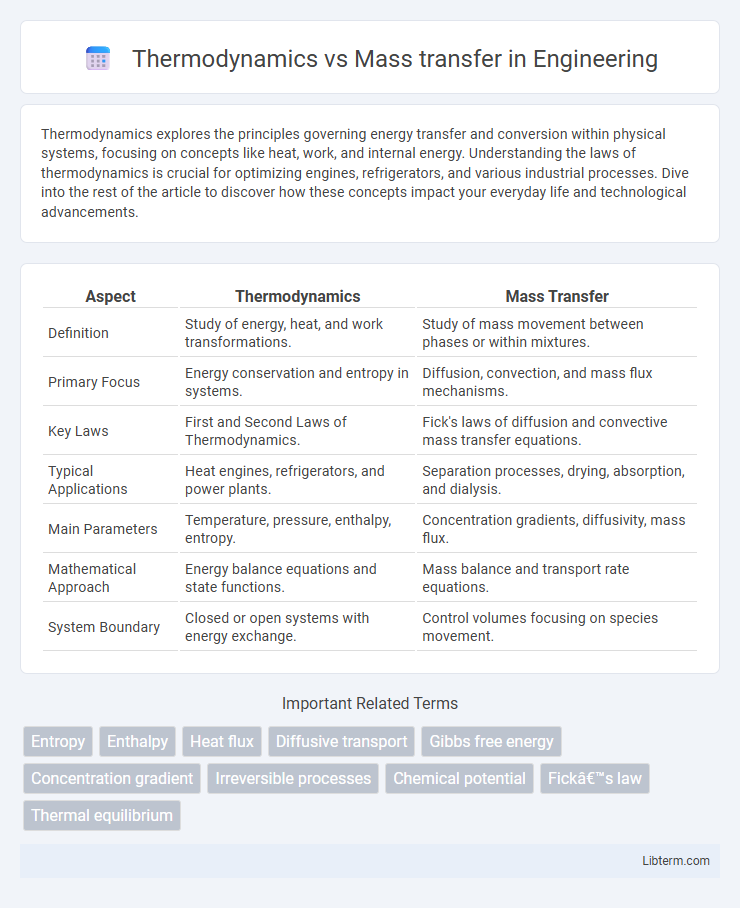Thermodynamics explores the principles governing energy transfer and conversion within physical systems, focusing on concepts like heat, work, and internal energy. Understanding the laws of thermodynamics is crucial for optimizing engines, refrigerators, and various industrial processes. Dive into the rest of the article to discover how these concepts impact your everyday life and technological advancements.
Table of Comparison
| Aspect | Thermodynamics | Mass Transfer |
|---|---|---|
| Definition | Study of energy, heat, and work transformations. | Study of mass movement between phases or within mixtures. |
| Primary Focus | Energy conservation and entropy in systems. | Diffusion, convection, and mass flux mechanisms. |
| Key Laws | First and Second Laws of Thermodynamics. | Fick's laws of diffusion and convective mass transfer equations. |
| Typical Applications | Heat engines, refrigerators, and power plants. | Separation processes, drying, absorption, and dialysis. |
| Main Parameters | Temperature, pressure, enthalpy, entropy. | Concentration gradients, diffusivity, mass flux. |
| Mathematical Approach | Energy balance equations and state functions. | Mass balance and transport rate equations. |
| System Boundary | Closed or open systems with energy exchange. | Control volumes focusing on species movement. |
Introduction to Thermodynamics and Mass Transfer
Thermodynamics studies energy transformations and the principles governing heat, work, and internal energy in physical and chemical processes. Mass transfer involves the movement of mass from one location to another through mechanisms like diffusion, convection, and phase change. Both fields are fundamental in chemical engineering, with thermodynamics providing the energy context and mass transfer describing the transport phenomena critical for reactor design and separation processes.
Fundamental Concepts of Thermodynamics
Thermodynamics studies energy transformations and the principles governing heat, work, and internal energy within physical systems, emphasizing concepts such as the first and second laws, entropy, and enthalpy. It provides foundational understanding for processes involving energy exchange, phase changes, and chemical reactions, essential for analyzing system stability and equilibrium. In contrast, mass transfer focuses on the movement of substances due to concentration gradients, but thermodynamics fundamentally describes the driving forces and energy changes underlying these mass transport phenomena.
Core Principles of Mass Transfer
Mass transfer involves the movement of mass from one location to another, driven by concentration gradients, pressure differences, or phase boundaries, fundamentally governed by Fick's laws of diffusion, mass convection, and mass transfer coefficients. Core principles emphasize diffusion, convection, and interphase mass transfer, which are essential for designing separation processes, chemical reactors, and environmental systems. Unlike thermodynamics that focuses on energy changes and equilibrium states, mass transfer principles quantify rates and mechanisms of species transport in various phases.
Key Differences Between Thermodynamics and Mass Transfer
Thermodynamics studies energy transformations and the laws governing equilibrium states in physical and chemical systems, emphasizing concepts like enthalpy, entropy, and Gibbs free energy. Mass transfer focuses on the movement of mass within phases or between phases driven by concentration gradients, involving mechanisms such as diffusion, convection, and mass flux. The key difference lies in thermodynamics addressing system energy balances and equilibrium conditions, whereas mass transfer analyzes the dynamic rates and mechanisms of species transport.
Applications of Thermodynamics in Engineering
Thermodynamics plays a crucial role in engineering by enabling the analysis and design of energy systems such as power plants, refrigeration cycles, and heat exchangers, where energy conversion and efficiency optimization are essential. It provides fundamental principles for assessing thermodynamic properties and phase equilibria, essential for chemical reactors, internal combustion engines, and HVAC systems. Unlike mass transfer, which focuses on species movement and concentration gradients, thermodynamics emphasizes energy interactions and system equilibrium critical for thermal engineering applications.
Applications of Mass Transfer in Industry
Mass transfer plays a critical role in various industrial processes such as distillation, absorption, extraction, and drying, where the movement of mass between phases is essential for product separation and purification. Industries like chemical manufacturing, food processing, and environmental engineering rely heavily on mass transfer principles to optimize efficiency and yield. Thermodynamics provides the foundational laws governing energy interactions, while mass transfer focuses specifically on the rates and mechanisms of material transport, making it indispensable for designing reactors, separators, and heat exchangers.
Interrelationship Between Thermodynamics and Mass Transfer
The interrelationship between thermodynamics and mass transfer is crucial in understanding the driving forces behind mass flux in systems involving phase equilibria and chemical reactions. Thermodynamics provides the foundation for determining phase equilibria, chemical potentials, and activity coefficients, which directly influence concentration gradients and mass transfer rates. Accurate modeling of mass transfer processes requires integrating thermodynamic principles to predict phase behavior, non-idealities, and energy changes affecting diffusion and convection phenomena.
Common Challenges in Thermodynamics and Mass Transfer
Common challenges in thermodynamics and mass transfer include accurately modeling non-ideal systems and predicting phase equilibria under varying temperature and pressure conditions. Both fields face difficulties in scaling laboratory data to industrial processes due to complex molecular interactions and heterogeneous mixtures. Precise measurement techniques and robust computational methods remain critical to overcoming uncertainties in heat and mass transport rates.
Advances in Thermodynamics and Mass Transfer Research
Recent advances in thermodynamics have enhanced the understanding of energy interactions at micro and nanoscale levels, improving predictive models for phase transitions and reactive systems. Innovations in mass transfer research include the development of high-efficiency membranes and novel separation techniques, significantly increasing transfer rates in industrial processes. Integrating thermodynamic principles with mass transfer dynamics has led to optimized reactor designs and improved process sustainability in chemical engineering.
Future Trends in Thermodynamics and Mass Transfer
Future trends in thermodynamics emphasize the integration of artificial intelligence with process simulations to optimize energy efficiency and reduce environmental impact in industrial applications. Advancements in nanotechnology and materials science are driving innovations in mass transfer, enabling enhanced separation processes and improved catalyst designs. The convergence of sustainable technologies and digital transformation is set to revolutionize both thermodynamics and mass transfer, promoting greener and more efficient chemical engineering solutions.
Thermodynamics Infographic

 libterm.com
libterm.com